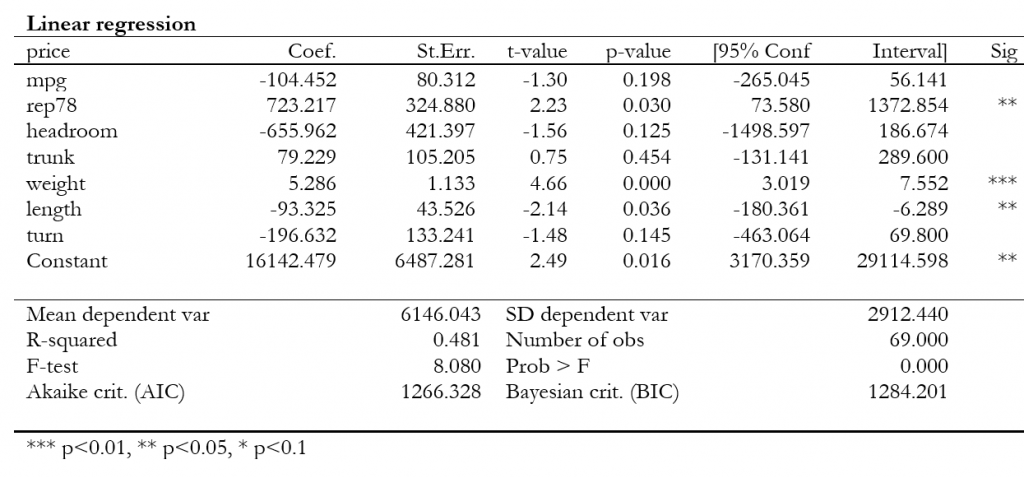

It is all based on the idea of the Standard Normal Distribution, where the Z value is the "Z-score"įor example the Z for 95% is 1.960, and here we see the range from -1.96 to +1.96 includes 95% of all values:įrom -1.96 to +1.96 standard deviations is 95%Īpplying that to our sample looks like this:Īlso from -1.96 to +1.96 standard deviations, so includes 95% Conclusion So an HR of 0.92 means the subjects were better off, and a 1.03 means slightly worse off. We are 95 confident that the true value of the coefficient in the model which generated this data falls within this value. The confidence interval is equal to the the coefficient +/- about 2 standard deviations. * Note for the curious: "HR" is used a lot in health research and means "Hazard Ratio" where lower is better. Just to drive the point home, STATA tells us this in one more way - using the confidence interval. "HR" is a measure of health benefit (lower is better), so it says that the true benefit of exercise for the wider population of men has a 95% chance of being between 0.88 and 0.97 had a "HR" (see below) with a mean of 0.92,.What is it saying? Looking at the "Male" line we see: Here is Confidence Interval used in actual research on extra exercise for older people: This is the risk in sampling, we might have a "bad" sample. So how do we know if our sample is one of the "lucky" 95% or the unlucky 5%? Unless we get to measure the whole population like above we simply don't know. That can happen about 5% of the time for a 95% confidence interval. Maybe we had this sample, with a mean of 83.5: Now the true mean might not be inside the confidence interval, but in 95% of the cases it will be!ĩ5% of all "95% Confidence Intervals" will include the true mean. but the true mean is inside our confidence interval of 86 ± 1.79 (in other words 84.21 to 87.79) and a standard deviation given by 2.5 (based on data.
#STATA CONFIDENCE INTERVAL CODE#
Stata has a pretty handy -twoway scatter- code that can be combined with -twoway rcap- to make the figure below. Let's lay all the apples on the ground from smallest to largest: In Exercises 5-8, assume that women's height are normally distributed with a mean given by 63.6 in. Dot and confidence interval figures in Stata. Now imagine we get to pick ALL the apples straight away, and get them ALL measured by the packing machine (this is a luxury not normally found in statistics!)
#STATA CONFIDENCE INTERVAL PROFESSIONAL#
So the true mean (of all the hundreds of apples) is likely to be between 84.21 and 87.79 True Mean Stata is programmable and this is a forum for professional and enthusiast programmers, so why not write your own program to do what you want The essence is that writing code to graph confidence intervals implies specifying (a) what confidence intervals you want (b) for what data (c) plotted how. Z is the Z-value = 1.960 (from the table above for 95%).help proportion) in Stata.There are hundreds of apples on the trees, so you randomly choose just 46 apples and get: To estimate the proportions and CIs over groups of gender, the commandįor more on the proportion command, refer to the Stata Reference, or Optionally, the citype 'wald' argument can be used to calculate Wald confidence intervals that match those returned by SAS. Compare to Stata: Wald confidence intervals. By default, it is a 95 confidence interval. To include missing values as a category of smoke, the command is. ucl is the upper bound of the confidence interval. To estimate the proportion of each smoking groupĪnd the corresponding CI, the command is. Smoke, with three categories, non-smoking, light-smoking,Īnd heavy-smoking. Gender, with two categories, male and female and proportion varlistĬan produce estimates of proportions, standard errors, and CIs for theĬategories identified by the values in each variable ofįor example, consider a data set consisting of two variables: In Stata, the confidence interval (CI) for a proportion can be Information here may no longer be accurate, and links may no longer be available or reliable. This content has been archived, and is no longer maintained by Indiana University. Stata Commands for Generating a Confidence Interval and Prediction Interval for Xh Y college student’s height, X1 mom’s height, X2 dad’s height, X3 1 if male, 0 if female There were n 165 usable cases in the dataset.


 0 kommentar(er)
0 kommentar(er)
